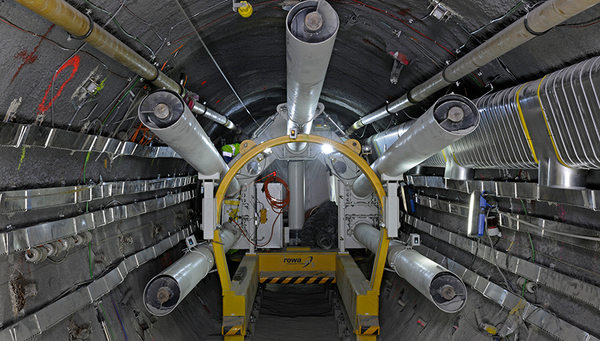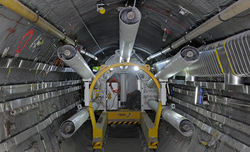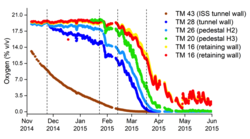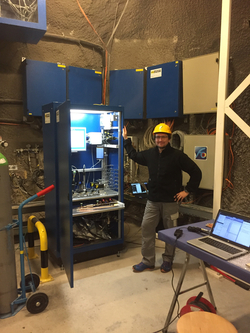Archive detail
Monitoring gas dynamics in a deep geological repository
January 31, 2019 |
The Mont Terri Rock Laboratory, lying to the north of Saint-Ursanne in the canton of Jura, is located at a depth of around 300 metres underground. At this site, various long-term experiments are being carried out as part of efforts to develop an operating plan for the safe disposal of radioactive waste.
In February 2015, an experiment was begun by Nagra (the National Cooperative for the Disposal of Radioactive Waste), designed to investigate the effects of the heat generated by decaying radioactive waste in a deep geological repository. For this purpose, three waste canisters with integrated heating elements (simulating the release of heat from spent fuel) were emplaced in a tunnel by Nagra scientists. The tunnel was subsequently backfilled with compacted bentonite granulate and sealed with a 5-metre-thick concrete plug. The behaviour of the backfill material and the host rock surrounding the tunnel (Opalinus Clay) is now being observed for a period of 10 years.
Monitoring gas dynamics
In August 2016, scientists from Eawag and Bern University joined this experiment to conduct an additional research project of a completely new kind. The aim is to investigate how the gas composition of residual air in the pore space of the bentonite material will change if water seeps into the tunnel over the coming decades or even thousands of years.
“At Eawag,“ explains Rolf Kipfer, Head of the Environmental Isotopes Group, “we recently developed a portable mass spectrometer that can measure a wide variety of gases on-site.” Thanks to the so-called Mini-Ruedi, analyses of environmental gases which previously required months of laboratory work can now be carried out rapidly in situ.
Kipfer’s colleague Yama Tomonaga – an expert on noble-gas dynamics in sediments – used a Mini-Ruedi device installed in the rock laboratory to continuously monitor concentrations of nine different gases (N2, O2, Ar, He, Kr, Xe, H2, CH4 and CO2) over the past two years. All these gases also occur in air – though in some cases at extremely low concentrations. In addition, conventional noble-gas analyses were performed off-site, and measurements were carried out using oxygen sensors installed in the tunnel by Nagra.
The researchers were surprised by some of the results: as predicted, measurements indicated that gas exchange occurs between the compacted bentonite granulate and pore water in the host rock. However, some of these processes occur differently – and in particular much more rapidly – than had been expected: the Opalinus Clay pore water acts both as a sink (e.g. for oxygen) and as a source for gases (e.g. helium, argon, methane, carbon dioxide).
Also studied were the concentrations of potentially flammable gases in the tunnel. Tomonaga’s conclusions are encouraging: “The accumulation of hydrogen (H2) and methane (CH4) is so limited that it poses no risks at present.”
Surprising findings for oxygen
On the basis of existing models, it was assumed that it would take decades or even longer for the oxygen present in the tunnel to disappear completely. Oxygen is known to be consumed, for example, by reactions with pyrite in the bentonite and in the Opalinus Clay, or by microbial activity.
But the time series from the Mont Terri Rock Laboratory told a different story: the experimental tunnel was almost oxygen-free after only a few months. At the same time, concentrations of nitrogen, argon and krypton increased. As regards the safety of a deep repository, the rapid decline in oxygen concentrations is good news, since corrosion of spent fuel storage canisters is much slower under anoxic conditions.
Following initial supplementary analyses at the Eawag laboratory in Dübendorf, the researchers now believe that the rapid consumption of oxygen is partly attributable to the backfill material in the tunnel. According to Yama Tomonaga, “Bentonite – a swelling clay – evidently acts in a similar way to activated carbon: gases are adsorbed and accumulate in this material.” This process – along with numerous other unresolved questions – is now to be investigated in more detail. Tomonaga explains: “At the moment, we know very little about how, for example, the instrumentation in the tunnel – sensors, cables, metal components, etc. – influences the gas dynamics.”
Another observation was intriguing even for the group’s most experienced gas specialists: gases from Opalinus Clay pore water interact with air trapped in the bentonite backfill even in the absence of water seeping into the tunnel. Rolf Kipfer says: “We see that gases are exchanged before any water is there! So we need to find an explanation for this process.”
Eawag has therefore decided to continue its experiments with the Mini-Ruedi. Niels Giroud, project leader at Nagra, welcomes this decision: “The studies of gas dynamics are extremely valuable for us. We’re also pleased that the findings to date are encouraging with regard to the long-term safety of a future repository.”
Eawag to join the Mont Terri Consortium
In summer 2019, Eawag – along with the Paul Scherrer Institute and ETH Zurich – is to become a Mont Terri Project Partner. This will facilitate access to the unique underground rock laboratory for Eawag scientists and allow them to carry out experiments independently.
Publications
Giroud, N., Tomonaga, Y., Wersin, P., Briggs, S., King, F., Vogt, T., & Diomidis, N. (2018). On the fate of oxygen in a spent fuel emplacement drift in Opalinus Clay. Appl. Geochem., 97, 270-278, http://doi.org/10.1016/j.apgeochem.2018.08.011.
Pictures
The FE tunnel. Visible in the foreground is a waste canister which, thanks to an integrated heating element, mimics the thermal behaviour of a future canister containing spent fuel. The cigarette-shaped tubes, used to convey the bentonite buffer material, are part of the backfilling machine.
(Photo: Nagra)
The layout of the FE experiment in the Mont Terri tunnel. The experiment is designed to investigate how the heat generated by decaying radioactive waste affects the host rock in a deep geological repository over the long term. For this purpose, three waste canisters with integrated heating elements (simulating the thermal behaviour of spent fuel) were emplaced in a tunnel by Nagra scientists. (Photo: Nagra)
A surprising finding: in the tunnel, the oxygen contained in the backfill material was consumed within a few months – rather than years, as had been expected.
(Source: Giroud et al. 2018)





